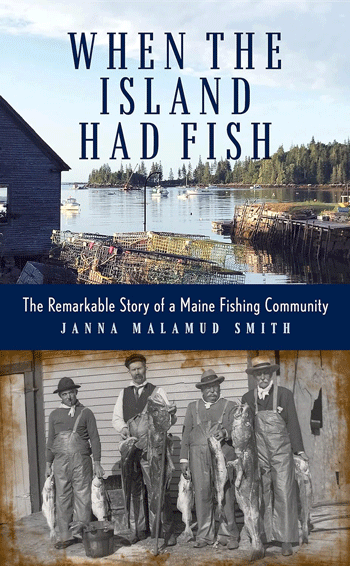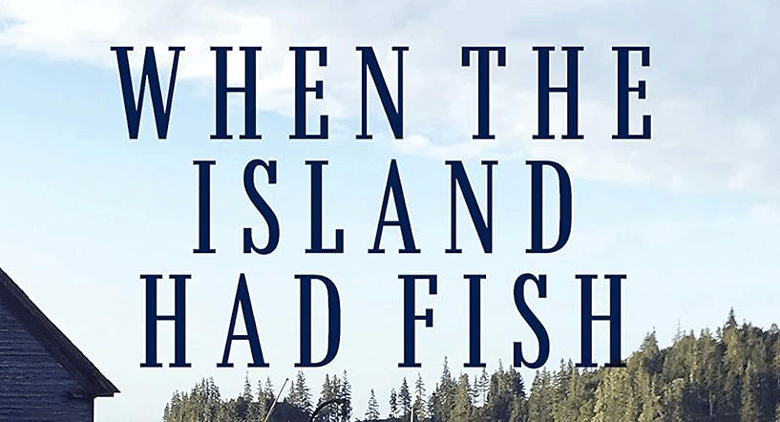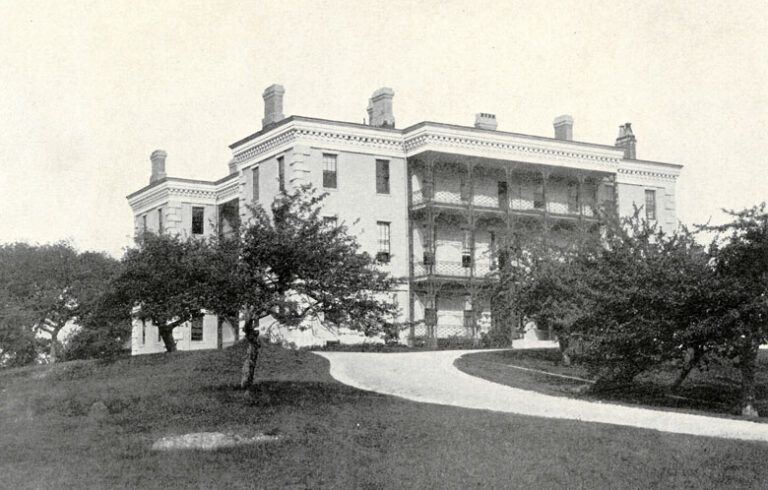When the Island Had Fish: The Remarkable Story of a Maine Fishing Community
By Janna Malamud Smith (DownEast Books, 2023)
I’ve been talking about When the Island Had Fish: The Remarkable Story of a Maine Fishing Community on Vinalhaven with everyone I know. Even at a recent funeral.
The story resonated among the gathered families because most remembered when islanders caught a wide variety of fish. Smith’s title refers to a time not all that long ago when there was cod, haddock, hake, and other finfish in Penobscot Bay. Now, folks hearing the title can be quick to add—as reflexively as knocking on wood—something like, “At least we’ve still got lobster.” Left unsaid is the biggest fear these days: Lobstering won’t end for us too, will it?
After that funeral, we enjoyed steamed lobster, sitting on a wharf alongside Carver’s Harbor, chock full of lobster boats. That industry is what defines Vinalhaven these days, but residents could point out to me features along the waterfront dating back to earlier days.
In the past, that harbor would have been just as crowded, and Main Street even busier, with vessels to take lumber or granite or fish from the island to ports along the East Coast.
Starting with Vinalhaven’s earliest inhabitants, Smith researched different groups who farmed, fished, and hunted here dating back 5,000 years and describes a group now called the Swordfish Hunters. She writes that different groups of Native peoples settled on these islands intermittently, and “the area was populated with various Abenaki tribes, the Maliseet, Passamaquoddy, Micmac, Penobscot—now called the Wabanaki Confederacy.”
Left unsaid is the biggest fear these days: Lobstering won’t end for us too, will it?
Vinalhaven was first mentioned European writing in 1603 when Martin Pring sailed from England in search of sassafras, which was used as a treatment in Europe for syphilis and plague. He didn’t find that in Maine but noted Penobscot Bay had abundant cod.
As more Europeans visited, some stayed. Settlers on Vinalhaven made the fishing grounds off-limits to the Native peoples living there; eventually many of them were killed, no doubt considered “savages” despite the clear success those families had had, not only fishing but hunting and raising food here.

After the American Revolution, more European-Americans came. With those settlers in the late 1700s and early 1800s, Vinalhaven history looks more familiar, with recognizable place and family names still present today, including Carver, Arey, Ames, Dyer, Lane, Calderwood, and Coombs.
As much as this book delves into the island’s history, with fascinating excerpts from public records, household inventories, diaries, and letters (much of it in the Vinalhaven Historical Society), more recent descriptions of Vinalhaven are interspersed, including photographs and quotes from interviews Smith began in 2008.
Her focus is on understanding how Vinalhaven has faced dramatic change in the past. It is a compelling story the way she tells it, thoughtful and insightful. (She is the author of award-winning books and a therapist, and has spent time on Vinalhaven since the early 1980s.) Smith is not only a good writer, interviewer, and researcher, but she is a personable narrator, showing empathy and respect for the community.
She sees the loss of finfish here as a result of factors such as industrialized fishing, climate change, and environmental degradation. And now, she worries that those on Vinalhaven now “only have one product to sell instead of several, they no longer possess a ready fallback when global consumption falters, or climate change drives the lobsters out of reach toward cooler waters.”
She closes the book with some passion, writing:
“We will all be impoverished if small-scale fishing for wild ocean fish ends permanently, and fishing families—on Vinalhaven and worldwide—die away. Of course, ‘everything changes,’ but the loss of communities… where land and water meet, is a disaster of a different order … all fishing communities are foundational. They have existed for thousands of years. The more urban and ‘virtual’ the world becomes, the more disconnected populations are from wildness, and from food sources and hunting and gathering, the more crucial it is for some among us to continue these earth-anchored practices.”
While the book could be read by some as alarming, realizing life-defining changes have indeed happened, others might feel relief knowing Vinalhaveners have come through past crises, and bring resilience and resourcefulness to facing the future.
But concern should be one of a reader’s reactions. This book helps us comprehend the precariousness of a fishing community on an island off Maine. Ask: who would Vinalhaveners be if not that, and what would give meaning to this life and place?
Tina Cohen is a writer and therapist who lives much of the year on Vinalhaven. Her essay “Sacred Space,” about the Pierce family who came to the island in 1796, was in the 2000 issue of Island Journal.





